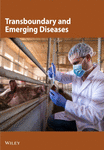Mapping Small Ruminant Trade Networks in Ethiopia’s Somali Region and Borena Zone: Implications for the Spread of Peste des Petits Ruminants Virus
Abstract
Livestock trade significantly contributes to the spread of transboundary animal diseases (TADs), like Peste des Petits Ruminants virus (PPRV), due to the long-distance movement of infected animals. This study investigates the structure and dynamics of the small ruminant trade network across 64 markets and 20 destinations, focusing on market connectivity, trade patterns, and disease risk. Eight key markets were identified due to their significant trading activity and connections. During the study period, 365,261 small ruminants were traded, with 54% directed toward market destinations and the remainder to slaughterhouses or cross-border locations, primarily Somaliland and Kenya. Over 85% of transport to these destinations was by truck, while more than 55% of internal movements were on foot. Trade peaked between July and September, accounting for 42% of the annual trade volume and 46% of cross-border movements. Network analysis revealed 172 distinct trade routes with varying activity levels: 12 persistent, 47 frequent, 42 intermediate, and 69 occasional. The network exhibited low connectivity (density = 0.024) and low reciprocity (0.104), with a negative assortativity (−0.52), indicating smaller markets often connected with larger ones. The network’s clustering coefficient was 0.729, and the average path length was 2.216, contrasting with simulated random networks that had a clustering coefficient of 0.047 and an average path length of 3.22. Key markets were identified as “gate-keepers” and “pulse takers,” facilitating connections between isolated and central markets. The epidemic threshold (q) and R0 indicated a high risk of disease spread, especially from July to October. The study found that removing key markets drastically reduced network cohesion, with a 10% removal of central nodes decreasing the giant strongly connected component (GSCC) size by ~80%. Peste des Petits Ruminants (PPR) outbreaks in 2023 correlated strongly with market centrality, highlighting the need for targeted monitoring and control measures. This study underscores the importance of understanding network dynamics to manage trade efficiently and mitigate disease risks in small ruminant populations.
Conflicts of Interest
The authors declare no conflicts of interest.
Open Research
Data Availability Statement
The data that support the findings of this study are available upon request from the corresponding author.




